| Columns Retired Columns & Blogs |
ATC SCM 11 loudspeaker Measurements
Sidebar 3: Measurements
The SCM 11's voltage sensitivity is specified as a fairly low 85.0dB/2.83V/m; this seemed a touch optimistic, as the ATC didn't seem to play any louder than the sample of the BBC LS3/5a that I routinely include when I'm set up to measure a bunch of loudspeakers. I estimated the ATC's sensitivity as being a low 82dB(B)/2.83V/m—this speaker should work best with higher-power amplifiers, though I note that JM had no drive difficulties with the Arcam Mini or Carat I57 receivers he used, and was impressed by the speaker's dynamic capabilities when he drove it with the Peachtree Nova. This was probably owing to the fact that the SCM 11's impedance remains above 8 ohms for most of the audioband, with a dip to 6 ohms between 100 and 300Hz, and to 4.8 ohms in the mid-treble (fig.1). Though there is a rather demanding combination of 5.5 ohms magnitude and –42° electrical phase angle at 3.3kHz, this shouldn't overtax well-designed amplifiers.
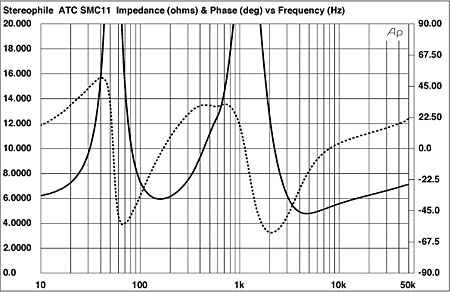
Fig.1 ATC SCM 11, electrical impedance (solid) and phase (dashed). (5 ohms/vertical div.)
There is a slight discontinuity between 500 and 600Hz in the impedance-magnitude trace, and an investigation of the enclosure panels' vibrational behavior with an accelerometer did uncover two fairly strong resonant modes on the sidewall in this region (fig.2). It's possible that these modes are high enough in frequency to have no subjective consequences—JM certainly didn't remark on any midrange congestion that might have been laid at the door of this behavior.
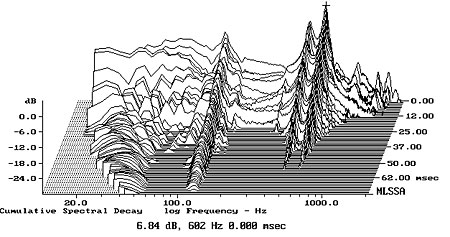
Fig.2 ATC SCM 11, cumulative spectral-decay plot calculated from output of accelerometer fastened to center of side panel (MLS driving voltage to speaker, 7.55V; measurement bandwidth, 2kHz).
The SCM 11 is somewhat unusual in having for its woofer a sealed-box alignment. As I've written before, all things being equal, a sealed-box design will give a more extended low-frequency performance in-room than a reflex (ported) design, due to the former's slower rolloff below resonance: 12dB/octave rather than 24dB/octave. The peak of 52 ohms at 53Hz in the impedance plot suggests that this is the tuning frequency for the SCM 11's woofer, which will be the frequency at which the response lies 6dB down from the midband reference. Fig.3, which shows the individual responses of the woofer (blue trace) and tweeter (red), confirms that the speaker's bass output is –6dB at 53Hz. A slight bump visible in the upper bass will be due to the nearfield measurement technique, but the woofer alignment appears to be a touch on the overdamped side, favoring control over richness.
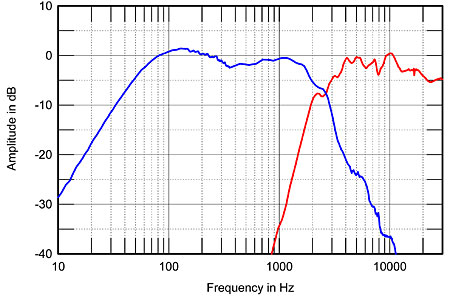
Fig.3 ATC SCM 11, acoustic crossover on tweeter axis at 50", corrected for microphone response, with nearfield responses of woofer (blue) and port (green) plotted below 350Hz and 1kHz, respectively.
Moving higher in frequency, the woofer is well behaved in its passband before crossing over to the tweeter close to the specified 2.8kHz. The tweeter is also well behaved, though its top octave is plateaued down by 3dB compared with the region between 4 and 11kHz. The acoustic crossover slopes are asymmetrical, with a 24dB/octave roll-in for the tweeter but closer to a second-order, 12dB/octave rollout for the woofer.
Fig.4 shows the SCM 11's response in the farfield with its grille off, averaged across a 30° horizontal window centered on the tweeter axis. It is superbly flat and even, though a slight lack of energy in the crossover region is evident. I wondered if this was the reason John Marks felt the speaker had a "smile" tonal character—ie, a slightly recessed mid-treble region—but the ATC's plot of lateral dispersion (fig.5) indicates that, in-room, the on-axis lack will be balanced by a degree of off-axis flare in the same region. However, there is a hint of increased directivity at the top of the woofer's passband that might have given rise to the "smile" characterization. The contour lines in this graph are otherwise even and well balanced, correlating with the excellent stereo imaging noted by JM. As usual with a 1" soft-dome tweeter used in a fairly wide baffle, the radiation pattern becomes more directional above 8kHz or so. Along with the shelved-down top octave, the ATC will sound a little mellow, even lacking in air, in rooms of medium to large size, or in small rooms with too many absorptive furnishings.
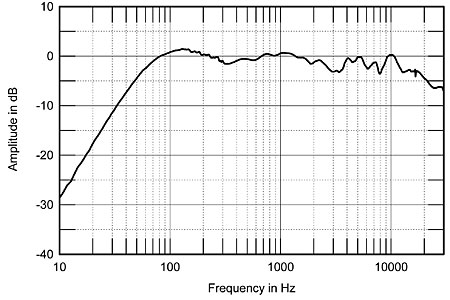
Fig.4 ATC SCM 11, anechoic response on tweeter axis at 50", averaged across 30° horizontal window and corrected for microphone response, with complex sum of nearfield responses plotted below 300Hz.
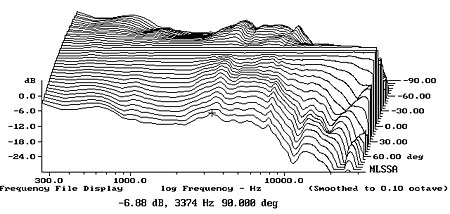
Fig.5 ATC SCM 11, lateral response family at 50", normalized to response on tweeter axis, from back to front: differences in response 90–5° off axis, reference response, differences in response 5–90° off axis.
In the vertical plane (fig.6), a deep suckout develops in the crossover region immediately above the tweeter axis. The SCM 11 needs to be used with a stand tall enough to place the listener's ears on or just below the tweeter axis if its balance is not to sound hollow. This pattern might also contribute to JM's "smile" in-room balance.
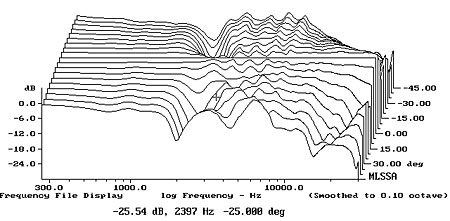
Fig.6 ATC SCM 11, vertical response family at 50", normalized to response on tweeter axis, from back to front: differences in response 45–5° above axis, reference response, differences in response 5–45° below axis.
The ATC's step response on the tweeter axis (fig.7) is absolutely conventional, with the tweeter's output leading the woofer's by 300µs or so and with both drivers connected in positive acoustic polarity. The SCM 11's cumulative spectral-decay plot (fig.8) is generally clean, but with some low-level hash evident in the mid-treble.
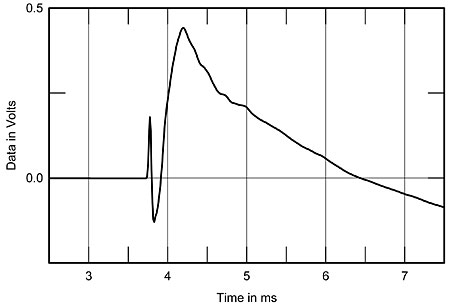
Fig.7 ATC SCM 11, step response on tweeter axis at 50" (5ms time window, 30kHz bandwidth).

Fig.8 ATC SCM 11, cumulative spectral-decay plot on tweeter axis at 50" (0.15ms risetime).
The ATC SCM 11 is a well-engineered little speaker. I am not surprised John Marks liked it as much as he did, though I would point out that its measured behavior suggests it will work better when listened to fairly close.—John Atkinson
- Log in or register to post comments




































